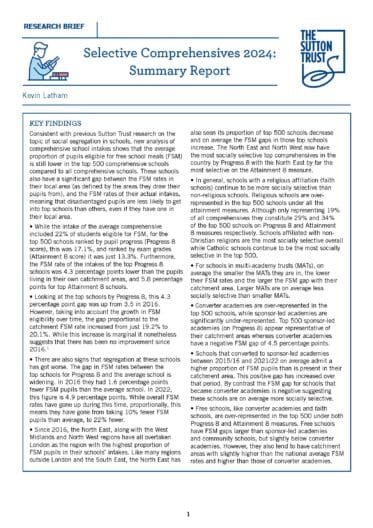- School leaders, including school governors, should implement a fair access review for their school. This should include reflecting on their year 7 intake each year and reviewing whether it reflects the local and national pictures in terms of levels of socio-economic disadvantage, as well as reviewing how their admissions policies could be adapted to address any inequalities. It is important to do this periodically, as intakes can see fluctuations year on year. Schools looking to become more socially diverse and inclusive should consider the following range of measures in relation to a) admissions policies and oversubscription criteria and b) the wider cost of schooling:
Making admissions policies fairer:
- Include pupil premium students in oversubscription priority criteria. The Schools Admissions Code currently allows for the use of pupil premium status as an oversubscription criterion, so more schools, particularly high performing schools, should move to implement this in order to create a more socially balanced intake and better reflect their local communities. This could for example mean giving pupil premium students priority up to the average proportion of those students in the local area, or up to a set level higher than this group’s proportion in the school’s current intake.
- Introducing either ballots or a banding system to determine the allocation of places when the school is oversubscribed. Introducing pupil premium priority is likely to help to improve access for the most disadvantaged pupils but will not necessarily alter the wider socio-economic mix of the student body. Introducing a system of ballots or banding has the potential to make a school’s intake more representative across the socio-economic spectrum.
-
- Ballots are where potential students are selected for admission using a lottery, meaning everyone entered for a place via the ballot has an equal chance of getting in. This could be done as a full ballot for all places or used only for a proportion of the school’s intake, such as ‘marginal lotteries’. This is where most school places could be allocated on the basis of existing criteria with a smaller proportion, say 20%, reserved for applicants outside the catchment allocated by lottery. The appropriate balance of ballot allocated places will depend on a school’s specific circumstances, including the profile of the neighbourhoods around the school.
- Banding tests are currently used by a number of schools. Pupils sit an entrance test, but rather than allocating places based on ability, places are allocated equally across all ability ‘bands’. This means a balance of abilities are admitted, which is likely to have a knock-on effect on the socio-economic profile of the school. Banding is most effective when there is cooperation between schools in an area, and where all children are entered for banding tests, with tests ideally being carried out in local primary schools. Groups of schools should thus be encouraged to develop a shared approach to admissions, possibly facilitated by a local authority or a local admissions forum.
- Particular care should be taken by schools with additional admissions criteria, including faith schools or those with a focus on a specific subject specialism (such as musical aptitude). This work has shown that on average faith schools are consistently more socially selective than non-religious schools. These schools should therefore take particular care to ensure their criteria are not contributing to socio-economic inequalities in access. This could be done, for example, by implementing policies such as pupil premium priority and having this priority apply before any of their own specific admissions criteria.
Reducing the cost of attending the school:
- School leaders should ensure that wherever possible, they remove potential financial barriers to attendance at their school. Financial concerns are a significant factor for parents from low-income households when making school choices. Therefore, schools should look to reduce these costs wherever practically possible. Unnecessary costs can include expensive uniforms, extensive equipment lists or expansive costs for trips or extra-curricular activities. On uniforms specifically, schools should commit to having no more than one branded item in their uniform, keeping total uniform costs under (or as near as possible to) £100 and ensuring second hand items are available for purchase or for free. Schools should also avoid collaborating with single uniform suppliers where possible, as this often increases the cost of uniforms. Where costs on any of these items cannot be avoided, schools should look to give financial support to lower income families, and to clearly advertise the availability of this support on the admissions pages of their website and at open days.
- Secondary and primary schools should collaborate to ensure that parents are well informed before making school choices, especially regarding their rights to free transport to school. For children eligible for FSM this extends to their three nearest suitable schools within six miles of their home, 15 miles for a faith school or up to 15 miles to their closest grammar school. Schools should ensure parents are aware of this support, and given information on how to access it, when making school choices

